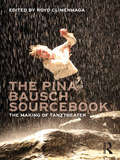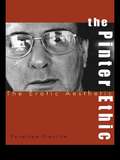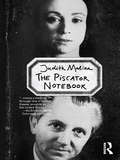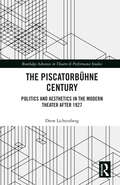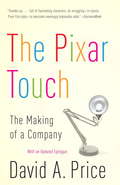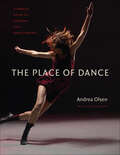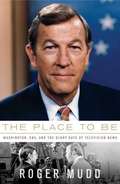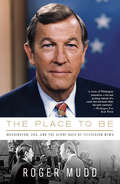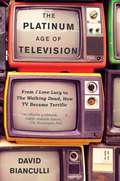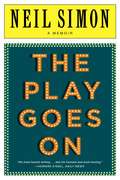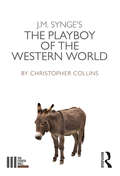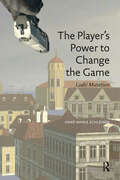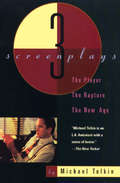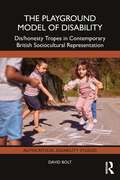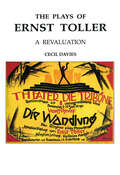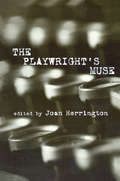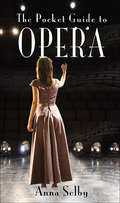- Table View
- List View
The Pina Bausch Sourcebook: The Making of Tanztheater
by Royd ClimenhagaPina Bausch’s work has had tremendous impact across the spectrum of late twentieth-century performance practice, helping to redefine the possibilities of what both dance and theater can be. This edited collection presents a compendium of source material and contextual essays that examine Pina Bausch's history, practice and legacy, and the development of Tanztheater as a new form, with sections including: Dance and theatre roots and connections; Bausch’s developmental process; The creation of Tanztheater; Bausch’s reception; Critical perspectives. Interviews, reviews and major essays chart the evolution of Bausch’s pioneering approach and explore this evocative new mode of performance. Edited by noted Bausch scholar, Royd Climenhaga, The Pina Bausch Sourcebook aims to open up Bausch’s performative world for students, scholars, dance and theatre artists and audiences everywhere.
The Pinata
by Rita Rosa Ruesga Soledad SebastianScholastic and Latin Grammy nominee Rita Rosa Ruega have rejoined to bring a new book of songs from the Hispanic tradition for all ages. Scholastic and Latin Grammy nominee Rita Rosa Ruega have rejoined to bring a new book of songs from the Hispanic tradition for all ages. Among the fourteen new songs are "Antón Pirulero," "Las mañanitas," and "A la rueda rueda". Full of beautiful illustrations and a brief description of the origin of each song, La piñata / The Piñata also include a link from where the songs--sung by the author--can be downloaded, as well as their music notation and guitar chords. Scholastic y Rita Rosa Ruesga, nominada al Grammy Latino, reanudan su colaboración con un nuevo libro de canciones hispanoamericanas para grandes y chicos que presenta catorce nuevas canciones de la tradición popular, entre ellas "Antón Pirulero", "La piñata" y "A la rueda rueda". Además de las hermosas ilustraciones y un enlace donde podrán bajar las canciones interpretadas por la autora, el libro también incluye partituras, acordes para guitarra y una breve explicación de la procedencia de cada canción.
The Ping-Pong Queen of Chinatown
by Andrew YangPerfect for fans of Ben Philippe and Mary H. K. Choi, this charming, insightful YA novel follows two high school students who form a complicated, ground-shifting bond while filming a movie.High school junior Felix Ma wants to prove to his parents that he’s not a quitter. After crashing out of piano lessons and competitive ping-pong, Felix starts a film club at his school in a last-ditch attempt to find a star extracurricular for his college applications.Then he meets Cassie Chow, a bubbly high school senior who shares Felix’s anxieties about the future and complicated relationship with parental expectations. Felix feels drawn to Cassie for reasons he can’t quite articulate, so as an excuse to see her more, he invites Cassie to star in his short film.The project starts out as a lighthearted mockumentary. But at the urging of Felix’s college admissions coach, who wants to turn the film into essay material, it soon morphs into a serious drama about the emotional scars that parents leave on their kids. As Felix and Cassie uncover their most painful memories, Cassie starts to balk at opening her wounds for the camera.With his parents and college admissions coach hot on his heels, Felix discovers painful truths about himself and his past—and must decide whether pleasing his parents is worth losing his closest friend.
The Pink Dress: A Memoir of a Reluctant Beauty Queen
by Jane Little BotkinFor fans of Little Miss Sunshine and Secrets of Miss America, this memoir from a national award-winning author reveals the reality of being the first Guyrex Girl in the 1970s. Beauty pageant stories have never been this raw, this real.Growing up in West Texas, Jane Little Botkin didn’t have designs on becoming a beauty queen. But not long after joining a pageant on a whim in college, she became the first protégé of El Paso’s Richard Guy and Rex Holt, known as the “Kings of Beauty”—just as the 1970’s counterculture movement began to take off. A pink, rose-covered gown—a Guyrex creation—symbolizes the fairy tale life that young women in Jane’s time imagined beauty queens had. Its near destruction exposes reality: the author’s failed relationship with her mother, and her parents’ failed relationship with one another. Weaving these narrative threads together is the Wild West notion that anything is possible, especially do-overs. The Pink Dress awakens nostalgia for the 1960s and 1970s, the era’s conflicts and growth pains. A common expectation that women went to college to get “MRS” degrees—to find a husband and become a stay-at-home wife and mother—often prevailed. How does one swim upstream against this notion among feminist voices that protest “If You Want Meat, Go to a Butcher!” at beauty pageants, two flamboyant showmen, and a developing awareness of self? Torn between women’s traditional roles and what women could be, Guyrex Girls evolved, as did the author.
The Pinter Ethic: The Erotic Aesthetic (Studies in Modern Drama #Vol. 2237)
by Penelope PrenticeFirst published in 2000. Routledge is an imprint of Taylor & Francis, an informa company.
The Piscator Notebook
by Judith Malina'Theater legend Malina has written one of the most interesting studies of the avant-garde theatrical movement published in the last several years.' – CHOICE Judith Malina and The Living Theatre have been icons of political theatre for over six decades. What few realise is that she originally studied under one of the giants of twentieth century culture, Erwin Piscator, in his Dramatic Workshop at The New School in New York. Piscator founded the Workshop after emigrating to New York, having collaborated with Brecht to create "epic theatre" in Germany. The Piscator Notebook documents Malina’s intensive and idiosyncratic training at Piscator’s school. Part diary, part theatrical treatise, this unique and inspiring volume combines: complete transcriptions of Malina’s diaries from her time as a student at the Dramatic Workshop, as well as reproductions of various of Piscator’s syllabi and teaching materials; notes on Malina’s teachers, fellow students – including Marlon Brando and Tennessee Williams – and New School productions; studies of Piscator’s process and influence, along with a new essay on the relationship between his teaching, Malina’s work with the Living Theatre and "The Ongoing Epic"; an introduction by performance pioneer, Richard Schechner. The Piscator Notebook is a compelling record of the genealogy of political theatre practice in the early 20th Century, from Europe to the US. But it is also a stunningly personal reflection on the pleasures and challenges of learning about theatre, charged with essential insights for the student and teacher, actor and director. 'Piscator is the greatest theatre man of our time.' – Bertolt Brecht
The Piscatorbühne Century: Politics and Aesthetics in the Modern Theater After 1927 (Routledge Advances in Theatre & Performance Studies)
by Drew LichtenbergThis study of the Piscatorbühne season of 1927–1928 uncovers a vital, previously neglected current of radical experiment in modern theater, a ghost in the machine of contemporary performance practices. A handful of theater seasons changed the course of 20th- and 21st-century theatre. But only the Piscatorbühne of 1927–1928 went bankrupt in less than a year. This exploration tells the story of that collapse, how it predicted the wider collapse of the late Weimar Republic, and how it relates to our own era of political polarization and economic instability. As a wider examination of Piscator’s contributions to dramaturgical and aesthetic form, The Piscatorbühne Century makes a powerful and timely case for the renewed significance of the broader epic theater tradition. Drawing on a rich archive of interwar materials, Drew Lichtenberg reconstructs this germinal nexus of theory and praxis for the modern theatre. This book will be of great interest to students and scholars in theatre, performance, art, and literature.
The Pixar Touch: The Making of a Company
by David A. PriceThe Pixar Touch is a lively chronicle of Pixar Animation Studios' history and evolution, and the "fraternity of geeks" who shaped it. With the help of animating genius John Lasseter and visionary businessman Steve Jobs, Pixar has become the gold standard of animated filmmaking, beginning with a short special effects shot made at Lucasfilm in 1982 all the way up through the landmark films Toy Story, Finding Nemo, Wall-E,and others. David A. Price goes behind the scenes of the corporate feuds between Lasseter and his former champion, Jeffrey Katzenberg, as well as between Jobs and Michael Eisner. And finally he explores Pixar's complex relationship with the Walt Disney Company as it transformed itself into the $7.4 billion jewel in the Disney crown.
The Place of Dance: A Somatic Guide to Dancing and Dance Making
by Andrea Olsen Caryn McHoseThe Place of Dance is written for the general reader as well as for dancers. It reminds us that dancing is our nature, available to all as well as refined for the stage. Andrea Olsen is an internationally known choreographer and educator who combines the science of body with creative practice. This workbook integrates experiential anatomy with the process of moving and dancing, with a particular focus on the creative journey involved in choreographing, improvising, and performing for the stage. Each of the chapters, or "days," introduces a particular theme and features a dance photograph, information on the topic, movement and writing investigations, personal anecdotes, and studio notes from professional artists and educators for further insight. The third in a trilogy of works about the body, including Bodystories: A Guide to Experiential Anatomy and Body and Earth: An Experiential Guide, The Place of Dance will help each reader understand his/her dancing body through somatic work, create a dance, and have a full journal clarifying aesthetic views on his or her practice. It is well suited for anyone interested in engaging embodied intelligence and living more consciously.Publication of this book is funded by the Beatrice Fox Auerbach Foundation Fund at the Hartford Foundation for Public Giving.
The Place to Be: Washington, CBS, and the Glory Days of Television News
by Roger MuddFamed journalist and broadcast anchor Roger Mudd recounts his days with CBS and how that news bureau operated during its heady days as a global information leader. From the congressional debate during the passing of the 1964 Civil Rights Act to Mudd's departure from CBS in 1980, he offers an insider's glimpse into the political events of the last half of the twentieth century with an informative, episodic narrative structure. Mudd offers equal doses of humor and meaning with each story of this memoir, which should appeal to anyone who has followed his career through the decades. Annotation ©2008 Book News, Inc., Portland, OR (booknews.com)
The Place to Be: Washington, CBS, and the Glory Days of Television News
by Roger MuddRoger Mudd joined CBS in 1961, and as the congressional correspondent, became a star covering the historic Senate filibuster debate over the 1964 Civil Right Act. Mudd was one of half a dozen major figures in the stable of CBS News broadcasters at time when the networkOCOs standing as a provider of news was at its peak. In "The Place to Be," Mudd tells of how the bureau worked: the rivalries, the egos, the pride, the competition, the ambitions and the gathering frustrations of conveying the world to a national television audience in thirty minutes minus commercials. It is the story of a unique TV news bureau, unmatched in its quality, dedication, and professionalism, that will highlight what TV journalism was once like and what itOCOs missing today.
The Plague Lords of Ruel (Lone Wolf Gamebook #13)
by Joe DeverYou are Grand Master Lone Wolf, last of the Kai Lords of Sommerlund and sole survivor of a massacre that wiped out the First Order of your elite warrior caste. It is the year MS 5075 and twenty-five years have passed since your brave kinsmen perished at the hands of the Darklords of Helgedad. These champions of evil, who were sent forth by Naar, the King of the Darkness, to destroy the fertile world of Magnamund, have themselves since been destroyed. You vowed to avenge the murder of the Kai and you kept your pledge, for it was you who brought about their downfall when alone you infiltrated their foul domain--the Darklands--and caused the destruction of their leader, Archlord Gnaag, and the core of their cancerous power that was the infernal city of Helgedad.
The Planet of Junior Brown: Zeely / The House Of Dies Drear / The Planet Of Junior Brown / M. C. Higgins, The Great / Sweet Whispers, Brother Rush
by Virginia HamiltonJunior Brown is a musical prodigy losing touch with reality and everyone around him—except for one important friend Junior Brown is different than the other kids in his eighth-grade class. For one, he weighs three hundred pounds. He&’s also a talented musician with a serious future as a professional pianist—if he survives middle school. With an overbearing mom, disappointed teachers, and fellow students who tease him mercilessly, Junior starts to slip away into his own mind. His last hope may be his only friend, Buddy Clark, a boy in his class without a home or family who has already learned some of life&’s toughest lessons.
The Platinum Age of Television: From I Love Lucy to The Walking Dead, How TV Became Terrific
by David BianculliTelevision shows have now eclipsed films as the premier form of visual narrative art of our time. This new book by one of our finest critics explains--historically, in depth, and with interviews with the celebrated creators themselves--how the art of must-see/binge-watch television evolved. Darwin had his theory of evolution, and David Bianculli has his. Bianculli's theory has to do with the concept of quality television: what it is and, crucially, how it got that way. In tracing the evolutionary history of our progress toward a Platinum Age of Television--our age, the era of The Sopranos and Breaking Bad and Mad Men and The Wire and Homeland and Girls--he focuses on the development of the classic TV genres, among them the sitcom, the crime show, the miniseries, the soap opera, the western, the animated series and the late night talk show. In each genre, he selects five key examples of the form, tracing its continuities and its dramatic departures and drawing on exclusive and in-depth interviews with many of the most famed auteurs in television history.Television has triumphantly come of age artistically; David Bianculli's book is the first to date to examine, in depth and in detail and with a keen critical and historical sense, how this inspiring development came about.
The Play Goes On: A Memoir
by Neil SimonIn his critically acclaimed Rewrites, Neil Simon talked about his beginnings -- his early years of working in television, his first real love, his first play, his first brush with failure, and, most moving of all, his first great loss. Simon's same willingness to open his heart to the reader permeates The Play Goes On. This second act takes the reader from the mid-1970s to the present, a period in which Simon wrote some of his most popular and critically acclaimed plays, including the Brighton Beach trilogy and Lost in Yonkers, for which he won the Pulitzer Prize. Simon experienced enormous professional success during this time, but in his personal life he struggled to find that same sense of happiness and satisfaction. After the death of his first wife, he and his two young daughters left New York for Hollywood. There he remarried, and when that foundered he remarried again. Told with his characteristic humor and unflinching sense of irony, The Play Goes On is rich with stories of how Simon's art came to imitate his life. Simon's forty-plus plays make up a body of work that is a long-running memoir in its own right, yet here, in a deeper and more personal book than his first volume, Simon offers a revealing look at an artist in crisis but still able and willing to laugh at himself.
The Playboy of the Western World (The Fourth Wall)
by Christopher Collins‘I’m thinking this night wasn’t I a foolish fellow not to kill my father in years gone by.’ – Christy Mahon On the first night of J. M. Synge’s The Playboy of the Western World (1907) the audience began protesting in the theatre; by the third night the protests had spilled onto the streets of Dublin. How did one play provoke this? Christopher Collins addresses The Playboy ’s satirical treatment of illusion and realism in light of Ireland’s struggle for independence, as well as Synge’s struggle for artistic expression. By exploring Synge’s unpublished diaries, drafts and notebooks, he seeks to understand how and why the play came to be. This volume invites the reader behind the scenes of this inflammatory play and its first performances, to understand how and why Synge risked everything in the name of art.
The Player's Power to Change the Game: Ludic Mutation (MediaMatters)
by Anne-Marie SchleinerIn recent decades, what could be considered a gamification of the world has occurred, as the ties between games and activism, games and war, and games and the city grow ever stronger. In this book, Anne-Marie Schleiner explores a concept she calls 'ludic mutation', a transformative process in which the player, who is expected to engage in the preprogramed interactions of the game and accept its imposed subjective constraints, seizes back some of the power otherwise lost to the game itself. Crucially, this power grab is also relevant beyond the game because players then see the external world as material to be reconfigured, an approach with important ramifications for everything from social activism to contemporary warfare.
The Player, The Rapture, The New Age: Three Screenplays (Books That Changed the World)
by Michael TolkinThree film scripts, including an Academy Award nominee, from the man described as an “Antonioni with a sense of humor” (The New Yorker). From his earliest works to the Emmy-nominated Showtime limited series Escape at Dannemora, Michael Tolkin is known as one of the industry’s biggest talents—and sharpest satirists. This volume contains three of his acclaimed screenplays. The Player, about the twisted world of Hollywood, was directed by Robert Altman and starred Tim Robbins and Greta Scacchi. It won an Edgar Award for Best Motion Picture Screenplay and has been hailed as “one of the smartest, funniest, most penetrating movies about moviemaking ever made” (Vanity Fair).The Rapture explores the emotionally intense, surreal world of Christian fundamentalism. The Los Angeles Times called it “a nervy, unsettling, edgy piece of work, that most audacious of cinematic ventures, a film of theological ideas, intent on looking into what we believe and why we believe it, determined, even eager, to explore the issues of heaven, hell, and the hereafter.”And The New Age tells the story of a young couple’s fall from financial grace and their quest for spirituality in a world defined by materialism.
The Playground Model of Disability: Dis/honesty Tropes in Contemporary British Sociocultural Representation (Autocritical Disability Studies)
by David BoltMore than being counter to what we must surely endeavour to consider the status quo of honesty, not to mention the pursuit of truth that should still be fundamental in academia and education more broadly, dishonesty involves deceit and thus victimisation, which is to say it tends to be used either against someone or to give someone an unfair advantage. Such personal interactions are sometimes and, in the context of this book, revealingly referred to as the games people play.When an unfair advantage is so given, someone else tends to be disadvantaged, an aspect of dishonesty that resonates with disablement. This book coins the term dis/honesty to define the many moments in which dishonesty is invoked by disability, and vice versa. The concept is explored via a selection of contemporary British sociocultural representations – namely, short jokes, disability sitcom, soap opera, activist radio interviews, fictionalised observations, and the robotic positionality of Artificial Intelligence.In investigating these representations of dis/honesty, on the basis that the blueprint of adult behaviour is found in the schoolyard, playground figurations are posited as part of the autocritical framework. Remarkably, there are many such relationships with disablement, for intrinsic to Piggy in the Middle, Leapfrog, Pile On, Hide and Seek, Blind Man’s Bluff, and Robot Tick, among other playground games, is interpersonal inequity, whereby a normative position is juxtaposed with one defined by being outnumbered, inhibited, and/or singled out.The playground model of disability reveals normative traditions that, according to a range of recent representations, people are often more than tempted to follow. Like a hegemonic game of Hopscotch, the way of the normative social order is sketched before us, complete with behavioural guidelines legitimised by repetition and competition. This book shows how dis/honesty tropes serve the normative social order and how the playground model can be used to critique instances in which disablement emanates from interactions more than institutions, people more than places.The Playground Model of Disability: Dis/honesty Tropes in Contemporary British Sociocultural Representation will be of particular interest to readers in disability studies, as well as those in humour studies, radio studies, media studies, television studies, literary studies, cultural studies, inclusion studies, drama, sociology, and critical theory.
The Plays of Ernst Toller: A Revaluation
by Cecil DaviesThis book is the fullest and most detailed study yet published in English of Ernst Toller's plays and their most significant productions. In particular the productions directed by Karl-Heinz Martin, Jurgen Fehling and Erwin Piscator are closely analyzed and the author demonstrates how, brilliant though they were, they obscured or even distorted Toller's intentions. The plays are seen as eminently stage-worthy while worth lies in Toller's use of language, both in prose and inverse. The neglected puppet-play The Scorned Lovers' Revenge is analyzed from a new perspective in the light, both of its language and its sexual theme, so important in Toller's writings as a whole. The reader is led to appreciate why Toller was regarded as the most outstanding German dramatist of his generation until, after his death in 1939 his reputation was overlaid by that of Brecht. This book should do much to restore Toller to his proper place in theatre history.
The Playwright's Muse (Studies in Modern Drama #Vol. 13)
by Joan HerringtonFirst Published in 2002. Routledge is an imprint of Taylor & Francis, an informa company.
The Plus: Self-Help for People Who Hate Self-Help
by Greg GutfeldNEW YORK TIMES BESTSELLER Greg Gutfeld wants to be your new guru, and he hates himself for it.Before Greg Gutfeld was a Fox News star and a New York Times bestselling author, he was a self-help writer for health magazines who had no idea what he was talking about. But now, after years of experience, he finally feels qualified to guide people on the journey of life—call this book punishment for his sins, and a huge reward for you! In The Plus, Greg teaches you how to brainwash yourself into better behavior, retaining the pluses in your life and eliminating the minuses. His approach to self-help is simple, and perfect for cynics; it&’s not about positive thinking in the short term, it&’s about positive being in the long term. With tough love and more than a little political incorrectness, he delivers sage wisdom such as: -If you aren&’t getting happier as you&’re getting older, you&’re doing it wrong. -Resist the media&’s command to expand destructive narratives. -If you&’re in the same place you were three years ago, wake up. -Don&’t tweet when drinking. Modern life grows emptier and emptier as society becomes increasingly polarized, and even those who don&’t subscribe to New Age beliefs are seeking comfort and meaning. In The Plus, Greg shows how skeptics too can advance themselves for the betterment of their lives and the healing of their communities.
The Pochsy Plays
by Karen HinesBeckett meets Betty Boop in this trilogy of monologues by Canadian cult heroine Pochsy, a nasty, vapid, utterly charming vixen. In 'Pochsy's Lips,' she's in the hospital, convinced she's sick because she's got a squid where her heart should be. In 'Oh Baby,' she's at the Last Resort, on holiday from her job packing mercury. And in 'Citizen Pochsy,' our little minx is in the waiting room at an audit from hell.In The Pochsy Plays, Hines remodels and melds traditions like stand-up, absurdism, clowning and neo-cabaret to create some of the most original and cutting satire to hit the stage - and, now, the page. Walk a mile in her distressed calfskin boots as the dark and ditzy Pochsy garbles ad slogans, self-help mantras and desperate grabs at meaning into a postmodern pastiche that is hilarious and harrowing, sweet and bitter at the same time.With extensive photos and musical scores, and an introduction by Darren O'Donnell.
The Pocket DJ
by Sarah LewitinnWith more than two thousand songs handpicked and organized by former Spin magazine writer and editor Sarah Lewitinn (aka Ultragrrrl), The Pocket DJ is the ultimate insider's reference guide for selecting music, downloading MP3s, and making all-purpose mixes for every occasion imaginable
The Pocket Guide to Opera
by Anna SelbyEverything you need to know about opera in one handy guide. Part of our best-selling Pocket Guide series, The Pocket Guide to Opera contains A-Z synopses of operas and biographies of the characters, lyricists and composers. The book features the history of opera, setting it in the context of its day and discussing the influence of world events and influences such as the Freemasons and the composers patrons. With factboxes highlighting surprising, little known and often quirky operatic facts, this fascinating book is a must-buy guide for everyone who loves opera.
